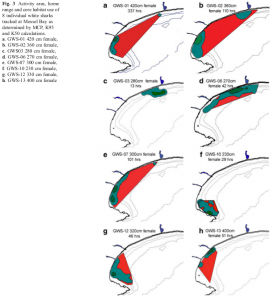An introduction to our animal movement studies
Posted by Enrico Gennari on May 31, 2013
Animal movement is a very large and interesting topic.
When I started working with marine animals I got very interested in describing the “movements” of white sharks in Mossel Bay. We put a simple acoustic transmitter on a white shark and followed it for several days (our longest track has been 107 hours continuously). This method allows us to look at dispersal and activity space. The following graphs have been recently published by our team in Environmental Biology of Fishes (2013: 96, pp.881-894), and show the activity spaces of several sharks within Mossel Bay.
As you can see Seal Island, Hartenbos, Kleinbrak and Grootbrak are focal areas in Mossel Bay.
A unique problem with active manual tracking of marine animals from a boat is that we work on a 2 dimensional field while the animal moves within a 3 dimensional environment. We therefore decided to incorporate transmitters with depth sensors into our tagging protocol. This allows, for instance, calculations of speed (as rate of movement: distance travelled divided by the time used to move that distance) in not just two, but three dimensions, which are more realistic estimations of the true speed of an animal. We were able to cluster different white shark behaviours in different areas of Mossel Bay, based on obviously position, but also swimming depth, swimming linearity and swimming speed. We differentiated behavioural types such as “resting” (swimming very slow at the bottom, sometimes almost drifting with current) from hunting for fish (“fishing”: swimming up and down -from the surface to the bottom in a yo-yo pattern-, back and forth –in a very localised area-, quite fast), from hunting for sea lions (swimming at a certain favourable depth, back and forth, quite fast), from travelling (swimming in a more sporadic yo-yo pattern, at medium speed) etc... This helps in answering the HOW part of the animal movement study.
Why do you think travelling for a white shark can not be too fast? 3 hints: metabolism, thermoregulation and energy expenditure.
In the same way that this novel branch of research has evolved, we soon realised that knowing the WHEN, WHERE and HOW, was not enough for us. We struggled to further develop our understanding of these movement processes with just simple description, so we started looking around at possible other avenues to get a better understanding of animal movement. We realised that a big effort was put into trying to characterise and model movement patterns. Animals can move for several reasons such as searching for food (hunger), searching for possible mates (passing own genes to the next generation), avoiding being preyed upon (fear), avoiding being harassed (stress), searching for better conditions in terms of habitat or in terms of space (i.e. overpopulation). Models such as random walks and Levy flights are attempts to look at underlying parameters which could help in understanding the biggest questions in animal movement studies which is WHY an animal moves. For instance if you were an albatross you may search randomly an area for food (random walk model) and if you don’t find anything you may want to move 'quite a bit' and start searching for food in another area (Levy flight model).
Can you guess which type of personality in mosquitofish would be the one more efficient in finding food in environments with scarce food supply?
